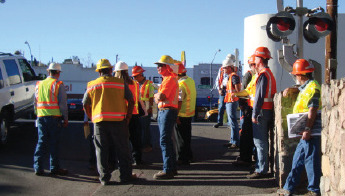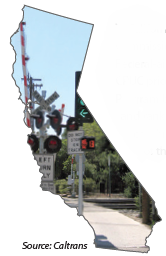Railway-Highway Crossings (Section 130) Program
NOTEWORTHY PRACTICE
Diagnostic Reviews for Rail-Highway Crossings:
Effective Partnering in California


FHWA-SA-18-071
Identifying rail-highway crossings that need safety improvements is an important element of State Section 130 Railway-Highway Crossing Programs. Agencies must develop processes for identifying crossings with safety concerns in addition to practices for determining which safety treatments to install to achieve the greatest safety benefits.

Source: FHWA
In California, rail-highway safety is a partnership between the California Public Utilities Commission (CPUC), and Caltrans, the State transportation agency that receives Federal-aid funds, including Section 130 Railway-Highway Crossings Program funding. CPUC prioritizes and selects safety improvement projects under the Section 130 Program by using a two-phase methodology. The first phase analyzes data to identify and rank crossings with potential safety issues, and the second phase involves conducting a rail-highway diagnostic review to determine the specific safety needs of the highest ranked intersections.
With more than 7,000 rail-highway grade crossings in the State, California has institutionalized a rail-highway diagnostic review process that includes a team of safety professionals with diverse backgrounds and safety perspectives.
The Diagnostic Review Process
"It's never a waste of time to observe a crossing," said Bree Arnett, the CPUC Section 130 Coordinator and a diagnostic review team leader for CPUC. "So many times I've made observations and identified safety hazards based on observed behavior," she noted.
The process for rail-highway crossing field diagnostic reviews generally parallels that of a traditional Road Safety Audit, which is a multi-step process designed to employ both data analysis and visual observation of a location to determine safety gaps and the treatments that can potentially address them.1
Preparation. The first step in the CPUC diagnostic review process takes place prior to meeting the team in the field. Information about the crossing is reviewed, including crash history, complaints from nearby residents or businesses, near-miss data from railroads, and any relevant locational factors that could have a safety impact (such as, a nearby school or community center). The review team leader is responsible for ensuring each team member has proper personal protective equipment for the field visit.

Field Review. The Field Diagnostic Team, which consists of representatives from the railroad company(s), local agency(s), Caltrans, CPUC staff, and other rail safety partners as appropriate (for example FHWA Division Office staff), then conducts a review of the selected crossing location. Each field review begins with a safety briefing and an overview of the process the team will use to review the site. The scope of the review is generally divided into two parts: vehicles and pedestrians. The diagnostic team first reviews vehicle behaviors and potential issues, then turns their attention to pedestrian safety concerns.
Summary of Findings and Follow Up. At end of the review, the Field Diagnostic Team develops a summary of their findings, including any suggested safety options or improvements. Once all the diagnostic reviews for the year are completed, CPUC selects the highest ranking crossings for treatment based on the funding anticipated to be available. CPUC then develops individual project packages for Caltrans, including a scope of work, conceptual plans, project development report, project timeline, and a cost estimate. The project packages, along with a final priority list, are then submitted to Caltrans for programming, environmental clearance, right-of-way certification and, ultimately, funding.
CPUC Section 130 Coordinator Bree Arnett believes the California diagnostic review process is a success because CPUC and Caltrans have been able to install treatments at locations selected for improvement based on data analysis. As a result, California applied robust safety improvements that address a rail-highway crossing from a holistic safety perspective, eliminating lingering safety issues that would require additional reviews year after year.
According to the requirement in 23 CFR 924.9(a)(4)(ii)(B), States are required to:
"(ii) Develop a Railway-Highway Crossings program that:(A) Considers the relative risk of public railway-highway crossings based on a hazard index formula;
(B) Includes onsite inspection of public railway-highway crossings; and
(C) Results in a program of highway safety improvement projects at railway-highway crossings giving special emphasis to the statutory requirement that all public crossings be provided with standard signing and markings."
1 FHWA, "Road Safety Audits" web page. Available at: https://www.fhwa.dot.gov/safety/proven-safety-countermeasures/road-safety-audit.
Page last modified on November 27, 2019
